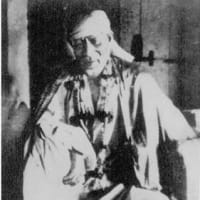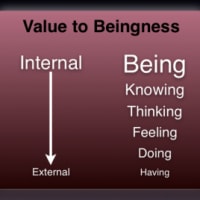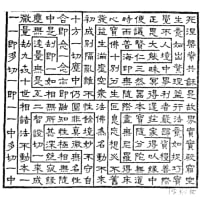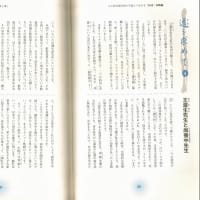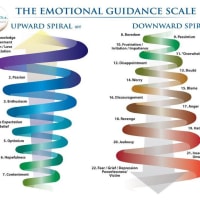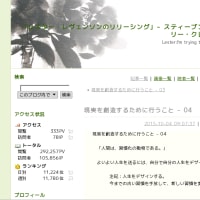page=27 - 調査:問題はありません。
page=27
present and available, here and now, in your life, in this moment. The only reason you can’t see it is because of the covering of limiting thoughts, feelings, beliefs, and wants that you have. Remove them, and your thinking will be more positive.
It is plain to see that, to a degree, your thinking does color your perception of the world; and, if you’re willing to stretch a little bit, you might even see that it colors what actually happens in your life. Here is a concrete example from sales. If you’re a salesperson and have a positive attitude―you feel good about yourself and good about your product―it’s easier to sell your product. Whereas, if you’ve had a bad day, experienced a series of rejections, or it’s been a long time since you made a sale, it is difficult to make sales, because you feel progressively less positive. That is the time to release. As a result, your thinking will be increasingly positive―and so will your world.
Have you noticed that the emphasis in this book, unlike the emphasis of most self- improvement programs, has nothing to do with getting you to modify your behavior? That’s because people naturally move in a positive direction through releasing. As I have already mentioned, lasting change, positive change, real change, comes from the inside out, not from trying to impose changes from the outside. Look to your past experiences to verify this point.
For instance, before you had the tools of the Method, you may have been able to quit smoking temporarily, only to have the habit reassert itself. Or perhaps you replaced smoking with overeating. Thus, in sublimating your urge, you possibly gained weight. The reason this happens is that when you push down a tendency in one spot, it usually pops up somewhere else. That is what most people and organizations do when they try to change from the outside in. It is different when you fully release a tendency. When you change from the inside out, the changes are lasting, and they’re positive. Every change you make using the Method brings you more overall freedom since it uncovers more of the unlimited potential of who you are.
I encourage you to ponder the “I” Diagram. Work with it. Take it for checking. Don’t believe it: prove it for yourself.
The Six Steps
The Six Steps are a distillation of the essence of the Sedona Method. They were created in 1974 by Lester Levenson to summarize the whole process of letting go. He had been working with a small group he was hoping to train as counselors-people who were helping him systematize his teachings into a do-it-yourself system-when he hit upon the Six Steps and wrote them down on the inside leaf of a book he was reading. Since then, they haven’t changed dramatically.
You may find it helpful to refer to the Six Steps whenever you are using the Method. Many people have reduced the list so it fits into their wallets or purses. I know of several others who have pasted the list into their Day-Timers. You could also hang them on the wall by your desk, or create a Six Steps screensaver on your computer to keep them handy and remind yourself to practice releasing throughout the day. I would also recommend that you keep a copy of the Six Steps in front of you when you sit down to do some focused or written releasing. Then, if you get stuck at any point, you can just look back at the Six Steps, and they will help you get unstuck. As I said, they represent the core of everything that you’ve been doing, and will continue to be doing, as you allow your exploration of the Method to unfold.
The Six Steps
1. Allow yourself to want freedom/imperturbability (your goal) more than you want approval, control, security, and separation.
2. Decide that you can release and be free/imperturbable (achieve your goal).
3. Allow yourself to perceive that all your feelings culminate in the four wants: the want of approval, the want to control, the want of security, and the want of separation. Then allow yourself to let go of the wants.
4. Make it constant. Release wanting approval, wanting to control, wanting security, and wanting to be separate all the time, whether you’re alone or with people.
5. If you are stuck, let go of wanting to control or change the stuckness.
6. Each time you release, you are lighter, happier, and more effective. If you do this continually, you will continually be lighter, happier, and more effective.
Now, let’s consider each of the Six Steps in turn.
Step 1: Allow yourself to want freedom/imperturbability (your goal) more than you want approval, control, security, and separation.
This step is not saying that you have to want freedom more than anything else. It also doesn’t mean that you won’t attain your goals or start to experience freedom until you have completely eliminated any sense of wanting approval, control, security, or separation. It does mean that the more you tip your inner scales in the direction of freedom/imperturbability, the more quickly you will see results in your life from the Method and the faster you’ll pull your goal into your awareness.
Interestingly, wanting freedom/imperturbability is what attracts us to this type of work. Many, if not most, people would prefer to remain unconscious. They’d literally rather not see that there’s a way out, that there’s an alternative. Because you have gotten this far into the process of the Sedona Method, rest assured that you’re one of the lucky people on this planet who are willing to change it for the better from the inside out.
You can reinforce your desire for freedom by choosing freedom as often as possible. If you’re having any doubts about whether or not to proceed with the Method, there’s a question that will help you to discriminate. It is very helpful, especially if you’re having difficulty letting go of an uncomfortable feeling.
• Would I rather have this stuckness (this feeling), or would I rather be free?
Most of the time, as soon as you ask this question, you’ll notice how the energy around the stuckness is starting to shift. Very often, the question by itself will cause you to let go of whatever it is that you’re holding on to in the moment.
Yes, we used the word “want” in the Step 1 statement. If you use this want to convert all your other wants into the desire for freedom, then you’ll no longer need it and it will fall away of its own accord.
Step 2: Decide that you can release and be free/imperturbable (achieve your goal) .
Every time you release, it’s just a decision, a simple choice. You have that choice to make in every moment of every day. Of course, this fact doesn’t indicate that you’ll always choose to release from now on. But as you make that choice―as you decide to do the Method and be free―it gets easier and easier to do. The more you can recognize that freedom is easily and readily available, the more likely you are to choose it.
Step 3: Allow yourself to perceive that all your feelings culminate in the four wants: the want of approval, the want to control, the want of security, and the want of separation. Then allow yourself to let go of the wants.
This step is the heart of the Method. As you continue to explore releasing, you’ll become more in tune with how your underlying basic wants cause you to feel other than the way you would choose and to act in ways that you later regret. As you increase your attunement, you will find yourself letting go spontaneously―immediately and with greater ease.
Step 4: Make it constant. Release wanting approval, wanting to control, wanting security, and wanting to be separate all the time, whether you’re alone or with people.
Every time there’s a problem, you have an opportunity to release and turn it around. Change your whole perspective on life by recognizing that every down is an opportunity to go even higher. Making the use of releasing constant is not a rule about a lot of doingness―although it might seem that way in the beginning―because you’re forming a new habit. It’s about becoming more aware of the unlimited potential that’s just behind whatever you’re experiencing. Making its use constant doesn’t mean that you’re asking the releasing questions all the time. It means that you’re relaxing into who you really are. You’re being at ease and as open as you’re able in order to release whatever emotion is arising in the NOW moment. You’re seeing the truth.
Letting go can become as second nature and apparently automatic as suppression and expression are now for most of us. Since we’re always doing something with our feelings anyway, why not just let them go?
Step 5: If you are stuck, let go of wanting to control or change the stuckness.
This step is so important that I devoted an entire chapter to it, Your Key to Serenity (see page 127). It is the safety valve of the Method, a single action that will set you straight, in most cases, and get you back on track when you’ve derailed. Specifically: When we want to change or control how we feel, we get stuck. Thus, when we let go of wanting to change or control how we feel in the NOW moment, the whole dynamic is changed.
It is so simple. Let go of wanting to change or control it if ...
• You’re feeling overwhelmed.
• You’re moving away from releasing.
• You’ve forgotten to release.
• You feel like you just can’t let go.
• You’re not sure what you are feeling.
• You find there are certain patterns that you’re having more difficulty letting go of than others.
• You simply want to cut to the chase and let go NOW.
Step 6: Each time you release, you are lighter, happier, and more effective. If you do this continually, you will continually be lighter, happier, and more effective.
As I mentioned in the Introduction, Lester used to call the Sedona Method the “bottoms- up method,” meaning that, as you use this technique, you’ll notice that what you may consider a peak: experience right now will eventually become where you bottom out. It’s not that there won’t still be ups and downs. As you release, your highs get higher but so do your lows. You might feel your feelings more acutely, because, as you release, you become more open, more sensitized, more discriminating. But even though you’re feeling your feelings more, you’re also letting go of them much more easily; because of that, you’ll see a rapid increase in your freedom over time.
This is the reason I encourage you to write down your gains as you work with this book. As you keep track of the positive changes in your life, you recognize, “Yes, I feel freer, I feel happier, things are getting easier, I’m becoming more effective.” As you acknowledge that, you’re feeding energy to the positive instead of the negative, and this will also cycle you back to Step 1. As you see that you are getting freer and happier, it strengthens your desire to have more of the same.
Explore a question that Lester used to ask himself: Could it get any better?
If it can get any better, when you release, it will.
Especially if you have a tendency to want to understand, after reading this chapter you may feel like the Sedona Method makes more sense. It is all based on repeatable formulas that work whenever you allow them to.
Exploration: There Are No Problems
調査:
問題はありません。
Before we move on to Part Two, I’d like to share one of the most powerful perspectives that we’ve been exploring in Sedona Method Advanced Courses with you: There are no problems in the present moment. I saved this piece for now, because I know this may be hard for you to accept, but―what if all the supposed problems you have right now are only memories? I challenge you to explore this question for yourself and at least entertain the possibility. If you can even partially accept this notion, and work with it as best you can in the way outlined here, it will give you another powerful tool to transform your life radically for the better.
私たちがパート2に移る前に、私は私たちがあなたとセドナ・メソッド高等科の中で調査している最も強力な展望のうちの1つを共有したい:
瞬時的現在に問題はありません。
これはあなたが受容するのが難しいかもしれないことを知っているので、私は今のところこの部分を節約しました、しかし起こりうる事態、今ちょうど持っている想像上の問題はすべて記憶だけです?
私は、自分のためにこの質問を調査し、かつ少なくとも可能性を楽しませるようにあなたに促します。
部分的にさえこの概念を受容することができ、最良のものとしてそれを用いて仕事をすることができる場合、あなたはできる(その方法で)概説した、ここで、よい方のためにあなたの生活を根本的に変形することはあなたに別の強力なツールを与えるでしょう。
The reason that problems appear to persist through time is that, whenever they’re not here, in this moment, we go looking for them. Yes, we actually seek our problems. We tend to filter our experiences based on the belief that we have a particular problem, unconsciously censoring anything from our awareness that doesn’t support that belief, including the fact that the problem is not here NOW.
それらがこの瞬間に、ここにない場合は常に、時間によって固執するために問題が現われる理由はそれです、私たちはそれらを捜しに行きます。
はい、私たちは実際に問題を求めます。
私たちは、私たちが、その問題が今ここにないという事実を含むその確信を支援しない意識からの何でも無意識に検閲して、特別の問題を持っているという確信に基づいた私たちの経験を濾過(ろか)する傾向があります。
I have worked with this perspective in the background of my awareness for many years; however it has only been in the last few years that I have used it in our classes and retreats. One of the first times I shared this perspective with a group was at a Seven-day Retreat a few years ago. Henry came to the retreat wearing a leg brace and feeling a lot of pain due to torn ligaments in his knee. His doctors had told him that the pain would probably persist for about six months until all the ligaments healed. So, he was quite skeptical when I told him that even pain is a memory. Yes, there were sensations in the NOW, but the pain itself was only a memory. He was so skeptical, in fact, that he spent the next 24 hours trying to prove me wrong. He was certain that if he got completely present with the sensations he was experiencing, he would still feel pain.
私は長年意識の背景のこの展望を用いて仕事をしました;
しかしながら、私が私たちのクラスと退却の中でそれを使用したのは単に過去数年でした。
私がグループとこの展望を共有した最初のときのうちの1つは、数年前に7日間の退却にありました。
ヘンリーは、脚締め金を着用していて、彼の膝の上に靱帯損傷により多くの苦痛を感じる退却に来ました。
彼の医者は、靭帯がすべて直るまで、苦痛が恐らく約6か月の間続くだろうと彼に伝えました。
したがって、苦痛さえが記憶であると私が彼に伝えた時、彼は全く懐疑的でした。
はい、今に感覚がありました。しかし、苦痛はそれ自身記憶だけでした。
彼は実際非常に懐疑的でした、彼は、私が間違っていることを証明しようとして次の24時間を過ごしました。
彼は、もし彼が経験していた感覚で完全に現在になれば、まだ苦痛を感じると確信しました。
The next day in class, Henry shared that he was more than a little shocked that, despite the fact he had doubted what I said, every time he looked for pain in the present, he couldn’t find it. He went on to explain that not only could he not find pain in the present, but there was no more pain to be found period, and his swelling had gone down about 85 percent. He also no longer needed his leg brace to walk!
クラスでの翌日、ヘンリーはそれを共有した、彼はいた、以上に、少し、衝撃を受けた、事実にもかかわらず、現在の痛みを捜すごとに、彼は私が言ったことを疑った、彼はそれを見つけることができませんでした。
彼は次にそれについて説明しました、だけでなく、できる、彼、現在に、だがそこに苦痛を見つけない、期間と分かられるこれ以上の苦痛および彼の膨潤でなかった、下へ約85パーセント行きました。
彼は、さらにもはや歩くために脚締め金を必要としませんでした!
I invite you to challenge your long cherished problems by embracing at least the possibility that they are only memories and allowing yourself to be open to what you discover.
私は、少なくともそれらが記憶だけである可能性を包含しあなた自身が、あなたが発見するものに開いていることを可能にすることにより、あなたの長い大事にされた問題に挑戦することをあなたに依頼します。
To release the suffering caused by your perceptions, begin by thinking of a problem that you used to believe you had. (Notice that I have purposely phrased this sentence in the past tense.)
あなたの知覚によって引き起こされた苦痛をリリースするためには、持っているとかつては信じたという問題について考えることにより始まってください。
(故意に私が過去時制中のこの文を表現したという通知。)
If you have a hard time accepting the problem as being from the past, allow yourself to include the last moment as part of the past. Most of us think of the past as at least yesterday, last year, or years ago. For the sake of understanding what I am suggesting, please view the past as anything that is not ha
過去からであることとしてその問題を認める困難を持っている場合は、あなた自身が過去の一部として最後の瞬間を含むことを可能にしてください。
私たちのうちのほとんどは過去について考えます、として、少なくとも昨日昨年、あるいは数年前に。
私が何を示唆しているか理解するために、1秒前に、あるいはナノ秒前を含め、この正確な瞬間に起こっていないものすべてとして過去を見てください。
-----
(For the sake of understanding what I am suggesting, please view the past as anything that is not happening at this exact moment, including a second ago, or even a nanosecond ago.
私が示唆しているものを理解のために、第二の前に、あるいはナノ秒前を含め、この正確な瞬間に起きていない何かのように過去をご覧ください。)
-----
page=27
present and available, here and now, in your life, in this moment. The only reason you can’t see it is because of the covering of limiting thoughts, feelings, beliefs, and wants that you have. Remove them, and your thinking will be more positive.
It is plain to see that, to a degree, your thinking does color your perception of the world; and, if you’re willing to stretch a little bit, you might even see that it colors what actually happens in your life. Here is a concrete example from sales. If you’re a salesperson and have a positive attitude―you feel good about yourself and good about your product―it’s easier to sell your product. Whereas, if you’ve had a bad day, experienced a series of rejections, or it’s been a long time since you made a sale, it is difficult to make sales, because you feel progressively less positive. That is the time to release. As a result, your thinking will be increasingly positive―and so will your world.
Have you noticed that the emphasis in this book, unlike the emphasis of most self- improvement programs, has nothing to do with getting you to modify your behavior? That’s because people naturally move in a positive direction through releasing. As I have already mentioned, lasting change, positive change, real change, comes from the inside out, not from trying to impose changes from the outside. Look to your past experiences to verify this point.
For instance, before you had the tools of the Method, you may have been able to quit smoking temporarily, only to have the habit reassert itself. Or perhaps you replaced smoking with overeating. Thus, in sublimating your urge, you possibly gained weight. The reason this happens is that when you push down a tendency in one spot, it usually pops up somewhere else. That is what most people and organizations do when they try to change from the outside in. It is different when you fully release a tendency. When you change from the inside out, the changes are lasting, and they’re positive. Every change you make using the Method brings you more overall freedom since it uncovers more of the unlimited potential of who you are.
I encourage you to ponder the “I” Diagram. Work with it. Take it for checking. Don’t believe it: prove it for yourself.
The Six Steps
The Six Steps are a distillation of the essence of the Sedona Method. They were created in 1974 by Lester Levenson to summarize the whole process of letting go. He had been working with a small group he was hoping to train as counselors-people who were helping him systematize his teachings into a do-it-yourself system-when he hit upon the Six Steps and wrote them down on the inside leaf of a book he was reading. Since then, they haven’t changed dramatically.
You may find it helpful to refer to the Six Steps whenever you are using the Method. Many people have reduced the list so it fits into their wallets or purses. I know of several others who have pasted the list into their Day-Timers. You could also hang them on the wall by your desk, or create a Six Steps screensaver on your computer to keep them handy and remind yourself to practice releasing throughout the day. I would also recommend that you keep a copy of the Six Steps in front of you when you sit down to do some focused or written releasing. Then, if you get stuck at any point, you can just look back at the Six Steps, and they will help you get unstuck. As I said, they represent the core of everything that you’ve been doing, and will continue to be doing, as you allow your exploration of the Method to unfold.
The Six Steps
1. Allow yourself to want freedom/imperturbability (your goal) more than you want approval, control, security, and separation.
2. Decide that you can release and be free/imperturbable (achieve your goal).
3. Allow yourself to perceive that all your feelings culminate in the four wants: the want of approval, the want to control, the want of security, and the want of separation. Then allow yourself to let go of the wants.
4. Make it constant. Release wanting approval, wanting to control, wanting security, and wanting to be separate all the time, whether you’re alone or with people.
5. If you are stuck, let go of wanting to control or change the stuckness.
6. Each time you release, you are lighter, happier, and more effective. If you do this continually, you will continually be lighter, happier, and more effective.
Now, let’s consider each of the Six Steps in turn.
Step 1: Allow yourself to want freedom/imperturbability (your goal) more than you want approval, control, security, and separation.
This step is not saying that you have to want freedom more than anything else. It also doesn’t mean that you won’t attain your goals or start to experience freedom until you have completely eliminated any sense of wanting approval, control, security, or separation. It does mean that the more you tip your inner scales in the direction of freedom/imperturbability, the more quickly you will see results in your life from the Method and the faster you’ll pull your goal into your awareness.
Interestingly, wanting freedom/imperturbability is what attracts us to this type of work. Many, if not most, people would prefer to remain unconscious. They’d literally rather not see that there’s a way out, that there’s an alternative. Because you have gotten this far into the process of the Sedona Method, rest assured that you’re one of the lucky people on this planet who are willing to change it for the better from the inside out.
You can reinforce your desire for freedom by choosing freedom as often as possible. If you’re having any doubts about whether or not to proceed with the Method, there’s a question that will help you to discriminate. It is very helpful, especially if you’re having difficulty letting go of an uncomfortable feeling.
• Would I rather have this stuckness (this feeling), or would I rather be free?
Most of the time, as soon as you ask this question, you’ll notice how the energy around the stuckness is starting to shift. Very often, the question by itself will cause you to let go of whatever it is that you’re holding on to in the moment.
Yes, we used the word “want” in the Step 1 statement. If you use this want to convert all your other wants into the desire for freedom, then you’ll no longer need it and it will fall away of its own accord.
Step 2: Decide that you can release and be free/imperturbable (achieve your goal) .
Every time you release, it’s just a decision, a simple choice. You have that choice to make in every moment of every day. Of course, this fact doesn’t indicate that you’ll always choose to release from now on. But as you make that choice―as you decide to do the Method and be free―it gets easier and easier to do. The more you can recognize that freedom is easily and readily available, the more likely you are to choose it.
Step 3: Allow yourself to perceive that all your feelings culminate in the four wants: the want of approval, the want to control, the want of security, and the want of separation. Then allow yourself to let go of the wants.
This step is the heart of the Method. As you continue to explore releasing, you’ll become more in tune with how your underlying basic wants cause you to feel other than the way you would choose and to act in ways that you later regret. As you increase your attunement, you will find yourself letting go spontaneously―immediately and with greater ease.
Step 4: Make it constant. Release wanting approval, wanting to control, wanting security, and wanting to be separate all the time, whether you’re alone or with people.
Every time there’s a problem, you have an opportunity to release and turn it around. Change your whole perspective on life by recognizing that every down is an opportunity to go even higher. Making the use of releasing constant is not a rule about a lot of doingness―although it might seem that way in the beginning―because you’re forming a new habit. It’s about becoming more aware of the unlimited potential that’s just behind whatever you’re experiencing. Making its use constant doesn’t mean that you’re asking the releasing questions all the time. It means that you’re relaxing into who you really are. You’re being at ease and as open as you’re able in order to release whatever emotion is arising in the NOW moment. You’re seeing the truth.
Letting go can become as second nature and apparently automatic as suppression and expression are now for most of us. Since we’re always doing something with our feelings anyway, why not just let them go?
Step 5: If you are stuck, let go of wanting to control or change the stuckness.
This step is so important that I devoted an entire chapter to it, Your Key to Serenity (see page 127). It is the safety valve of the Method, a single action that will set you straight, in most cases, and get you back on track when you’ve derailed. Specifically: When we want to change or control how we feel, we get stuck. Thus, when we let go of wanting to change or control how we feel in the NOW moment, the whole dynamic is changed.
It is so simple. Let go of wanting to change or control it if ...
• You’re feeling overwhelmed.
• You’re moving away from releasing.
• You’ve forgotten to release.
• You feel like you just can’t let go.
• You’re not sure what you are feeling.
• You find there are certain patterns that you’re having more difficulty letting go of than others.
• You simply want to cut to the chase and let go NOW.
Step 6: Each time you release, you are lighter, happier, and more effective. If you do this continually, you will continually be lighter, happier, and more effective.
As I mentioned in the Introduction, Lester used to call the Sedona Method the “bottoms- up method,” meaning that, as you use this technique, you’ll notice that what you may consider a peak: experience right now will eventually become where you bottom out. It’s not that there won’t still be ups and downs. As you release, your highs get higher but so do your lows. You might feel your feelings more acutely, because, as you release, you become more open, more sensitized, more discriminating. But even though you’re feeling your feelings more, you’re also letting go of them much more easily; because of that, you’ll see a rapid increase in your freedom over time.
This is the reason I encourage you to write down your gains as you work with this book. As you keep track of the positive changes in your life, you recognize, “Yes, I feel freer, I feel happier, things are getting easier, I’m becoming more effective.” As you acknowledge that, you’re feeding energy to the positive instead of the negative, and this will also cycle you back to Step 1. As you see that you are getting freer and happier, it strengthens your desire to have more of the same.
Explore a question that Lester used to ask himself: Could it get any better?
If it can get any better, when you release, it will.
Especially if you have a tendency to want to understand, after reading this chapter you may feel like the Sedona Method makes more sense. It is all based on repeatable formulas that work whenever you allow them to.
Exploration: There Are No Problems
調査:
問題はありません。
Before we move on to Part Two, I’d like to share one of the most powerful perspectives that we’ve been exploring in Sedona Method Advanced Courses with you: There are no problems in the present moment. I saved this piece for now, because I know this may be hard for you to accept, but―what if all the supposed problems you have right now are only memories? I challenge you to explore this question for yourself and at least entertain the possibility. If you can even partially accept this notion, and work with it as best you can in the way outlined here, it will give you another powerful tool to transform your life radically for the better.
私たちがパート2に移る前に、私は私たちがあなたとセドナ・メソッド高等科の中で調査している最も強力な展望のうちの1つを共有したい:
瞬時的現在に問題はありません。
これはあなたが受容するのが難しいかもしれないことを知っているので、私は今のところこの部分を節約しました、しかし起こりうる事態、今ちょうど持っている想像上の問題はすべて記憶だけです?
私は、自分のためにこの質問を調査し、かつ少なくとも可能性を楽しませるようにあなたに促します。
部分的にさえこの概念を受容することができ、最良のものとしてそれを用いて仕事をすることができる場合、あなたはできる(その方法で)概説した、ここで、よい方のためにあなたの生活を根本的に変形することはあなたに別の強力なツールを与えるでしょう。
The reason that problems appear to persist through time is that, whenever they’re not here, in this moment, we go looking for them. Yes, we actually seek our problems. We tend to filter our experiences based on the belief that we have a particular problem, unconsciously censoring anything from our awareness that doesn’t support that belief, including the fact that the problem is not here NOW.
それらがこの瞬間に、ここにない場合は常に、時間によって固執するために問題が現われる理由はそれです、私たちはそれらを捜しに行きます。
はい、私たちは実際に問題を求めます。
私たちは、私たちが、その問題が今ここにないという事実を含むその確信を支援しない意識からの何でも無意識に検閲して、特別の問題を持っているという確信に基づいた私たちの経験を濾過(ろか)する傾向があります。
I have worked with this perspective in the background of my awareness for many years; however it has only been in the last few years that I have used it in our classes and retreats. One of the first times I shared this perspective with a group was at a Seven-day Retreat a few years ago. Henry came to the retreat wearing a leg brace and feeling a lot of pain due to torn ligaments in his knee. His doctors had told him that the pain would probably persist for about six months until all the ligaments healed. So, he was quite skeptical when I told him that even pain is a memory. Yes, there were sensations in the NOW, but the pain itself was only a memory. He was so skeptical, in fact, that he spent the next 24 hours trying to prove me wrong. He was certain that if he got completely present with the sensations he was experiencing, he would still feel pain.
私は長年意識の背景のこの展望を用いて仕事をしました;
しかしながら、私が私たちのクラスと退却の中でそれを使用したのは単に過去数年でした。
私がグループとこの展望を共有した最初のときのうちの1つは、数年前に7日間の退却にありました。
ヘンリーは、脚締め金を着用していて、彼の膝の上に靱帯損傷により多くの苦痛を感じる退却に来ました。
彼の医者は、靭帯がすべて直るまで、苦痛が恐らく約6か月の間続くだろうと彼に伝えました。
したがって、苦痛さえが記憶であると私が彼に伝えた時、彼は全く懐疑的でした。
はい、今に感覚がありました。しかし、苦痛はそれ自身記憶だけでした。
彼は実際非常に懐疑的でした、彼は、私が間違っていることを証明しようとして次の24時間を過ごしました。
彼は、もし彼が経験していた感覚で完全に現在になれば、まだ苦痛を感じると確信しました。
The next day in class, Henry shared that he was more than a little shocked that, despite the fact he had doubted what I said, every time he looked for pain in the present, he couldn’t find it. He went on to explain that not only could he not find pain in the present, but there was no more pain to be found period, and his swelling had gone down about 85 percent. He also no longer needed his leg brace to walk!
クラスでの翌日、ヘンリーはそれを共有した、彼はいた、以上に、少し、衝撃を受けた、事実にもかかわらず、現在の痛みを捜すごとに、彼は私が言ったことを疑った、彼はそれを見つけることができませんでした。
彼は次にそれについて説明しました、だけでなく、できる、彼、現在に、だがそこに苦痛を見つけない、期間と分かられるこれ以上の苦痛および彼の膨潤でなかった、下へ約85パーセント行きました。
彼は、さらにもはや歩くために脚締め金を必要としませんでした!
I invite you to challenge your long cherished problems by embracing at least the possibility that they are only memories and allowing yourself to be open to what you discover.
私は、少なくともそれらが記憶だけである可能性を包含しあなた自身が、あなたが発見するものに開いていることを可能にすることにより、あなたの長い大事にされた問題に挑戦することをあなたに依頼します。
To release the suffering caused by your perceptions, begin by thinking of a problem that you used to believe you had. (Notice that I have purposely phrased this sentence in the past tense.)
あなたの知覚によって引き起こされた苦痛をリリースするためには、持っているとかつては信じたという問題について考えることにより始まってください。
(故意に私が過去時制中のこの文を表現したという通知。)
If you have a hard time accepting the problem as being from the past, allow yourself to include the last moment as part of the past. Most of us think of the past as at least yesterday, last year, or years ago. For the sake of understanding what I am suggesting, please view the past as anything that is not ha
過去からであることとしてその問題を認める困難を持っている場合は、あなた自身が過去の一部として最後の瞬間を含むことを可能にしてください。
私たちのうちのほとんどは過去について考えます、として、少なくとも昨日昨年、あるいは数年前に。
私が何を示唆しているか理解するために、1秒前に、あるいはナノ秒前を含め、この正確な瞬間に起こっていないものすべてとして過去を見てください。
-----
(For the sake of understanding what I am suggesting, please view the past as anything that is not happening at this exact moment, including a second ago, or even a nanosecond ago.
私が示唆しているものを理解のために、第二の前に、あるいはナノ秒前を含め、この正確な瞬間に起きていない何かのように過去をご覧ください。)
-----










